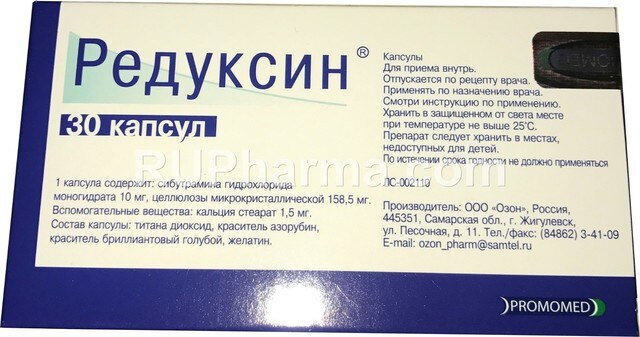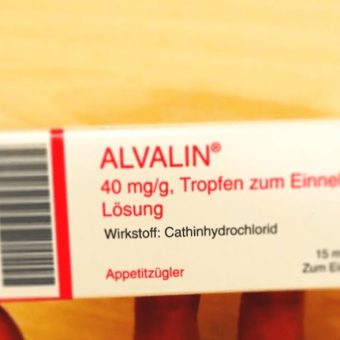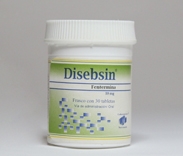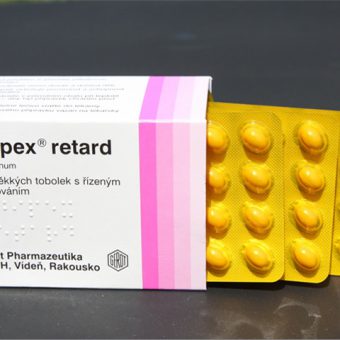Description
Reduxin ® is a combined preparation whose action is due to its constituent components.
Sibutramine is a prodrug and exerts its effect in vivo due to metabolites (primary and secondary amines) that inhibit the reuptake of monoamines (serotonin, norepinephrine and dopamine). An increase in the content of neurotransmitters in the synapses increases the activity of central 5-HT-serotonin and adrenergic receptors, which contributes to an increase in satiety and a decrease in food demand, as well as an increase in thermal production. By indirectly activating beta 3 -adrenoreceptors, sibutramine acts on brown adipose tissue. Weight loss accompanied by an increase in plasma concentrations of HDL and a decrease in amount of triglycerides, total Xc , LDLand uric acid. Sibutramine and its metabolites do not affect the release of monoamines, do not inhibit MAO; have a low affinity for a large number of neurotransmitter receptors, including serotonin (5-HT 1 , 5-HT 1A , 5-HT 1B , 5-HT 2C ), adrenergic (beta 1 -, beta 2 -, beta 3 -, alpha 1 – , alpha 2 -), dopamine (D 1 , D 2 ), muscarinic, histamine (H 1 ), benzodiazepine and glutamate (NMDA) receptors.
MCC is an enterosorbent, has sorption properties and a nonspecific detoxification effect. It binds and eliminates various microorganisms, products of their vital activity, toxins of exogenous and endogenous nature, allergens, xenobiotics, as well as an excess of certain metabolic products and metabolites responsible for the development of endogenous toxicosis.
Pharmacokinetics
After oral administration, it is rapidly absorbed from the gastrointestinal tract by at least 77%. During the initial passage through the liver, it undergoes biotransformation under the influence of the CYP3A 4 isoenzyme with the formation of two active metabolites – monodesmethylsibutramine (M1) and didesmethylsibutramine (M2). After a single dose of 15 mg C max in plasma, M1 is 4 ng / ml (3.2–4.8 ng / ml), M2 is 6.4 ng / ml (5.6–7.2 ng / ml) . C max is reached after 1.2 hours (sibutramine), 3-4 hours (M1 and M2). A simultaneous meal lowers C max metabolites by 30% and increases the time to reach it by 3 hours without changing AUC. It is quickly distributed on tissues. Communication with proteins is 97 (sibutramine) and 94% (M1 and M2). C ss of active metabolites in blood plasma is reached within 4 days after the start of use and is approximately 2 times higher than the concentration in the blood plasma after taking a single dose. T 1/2 of sibutramine – 1.1 hours, M1 – 14 hours, M2 – 16 hours. Active metabolites undergo hydroxylation and conjugation with the formation of inactive metabolites, which are excreted mainly by the kidneys.
Special patient groups
Floor. Currently available limited data do not indicate the existence of clinically significant differences in pharmacokinetics in men and women.
Elderly age. Pharmacokinetics in elderly healthy individuals (average age – 70 years) is similar to that in young people.
Renal failure. Renal failure does not affect the AUC of the active metabolites M1 and M2, except for the metabolite M2 in patients with end-stage renal failure undergoing dialysis.
Liver failure. In patients with moderate hepatic insufficiency after a single intake of sibutramine AUC, the active metabolites M1 and M2 are 24% higher than in healthy individuals.
Indications Reduxin ®
To reduce body weight in the following conditions:
alimentary obesity with a BMI of 30 kg / m 2 or more;
Alimentary obesity with a BMI of 27 kg / m 2 or more in combination with type 2 diabetes and dyslipidemia.
Contraindications
established hypersensitivity to sibutramine or other components of the drug;
the presence of organic causes of obesity (e.g. hypothyroidism);
serious eating disorders (anorexia nervosa or bulimia nervosa);
mental illness;
Gilles de la Tourette syndrome (generalized tics);
concomitant use of MAO inhibitors ( including phentermine, fenfluramine, dexfenfluramine, ethylamphetamine, ephedrine) or their use for 2 weeks before taking Reduxin ® and 2 weeks after the end of its administration; other drugs acting on the central nervous system that inhibit the reuptake of serotonin ( including antidepressants), antipsychotics, sleeping pills containing tryptophan, as well as other centrally acting drugs to reduce body weight or to treat mental disorders;
cardiovascular diseases (history and at present): coronary heart disease (myocardial infarction, angina pectoris); chronic heart failure in the stage of decompensation, peripheral arterial occlusion diseases, tachycardia, arrhythmia, cerebrovascular diseases (stroke, transient cerebrovascular disorders);
uncontrolled arterial hypertension (blood pressure above 145/90 mm Hg. Art. – see “Special instructions”);
thyrotoxicosis;
severe violations of the liver and / or kidneys;
benign prostatic hyperplasia;
pheochromocytoma;
angle-closure glaucoma;
established pharmacological, drug or alcohol dependence;
pregnancy;
the period of breastfeeding;
age up to 18 years and over 65 years.
With caution: a history of arrhythmia; chronic circulatory failure; diseases of the coronary arteries ( including a history), except for coronary heart disease (myocardial infarction, angina pectoris); glaucoma, except angle-closure glaucoma; cholelithiasis; arterial hypertension (controlled and history); neurological disorders, including mental retardation and convulsions ( including history); epilepsy; impaired liver and / or kidney function of mild to moderate severity; a history of motor and verbal tics; tendency to bleeding, blood clotting disorder; taking drugs that affect hemostasis or platelet function.
Pregnancy and lactation
Since so far there is not a large enough number of studies regarding the safety of the effects of sibutramine on the fetus, this drug is contraindicated during pregnancy.
Women who are of reproductive age should use contraceptives while taking Reduxin ® .
It is contraindicated to take Reduxin ® during breastfeeding.





Reviews
There are no reviews yet.